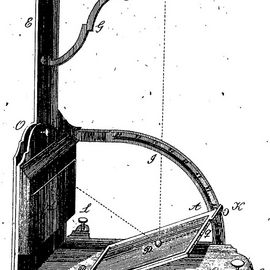Apparatus to show reflection in elastic shocks
English description:
Apparatus to show reflection in elastic shocks. Described by Jean-Antoine Nollet in "Leçons de physique expérimentale" (Paris, 1743-1748).
Hauch's text in "Det Physiske Cabinet" (1836-38):
AB (Pl. 4, Fig. 13) is a plan-cut and polished marble slab, which is fastened by hinges in B to the plank CD, so that it can be lifted at will and fastened at any point of the arch I, by the screw K. On one of the narrow sides of the plank CD, which can be set completely horizontally by the three screws L, L, L, is erected a vertical Stand E, which carries the horizontal piece of wood FH, by means of the piece of wood G. FH is drilled through at H, so that a small ivory ball of 6 to 8 lines in diameter can comfortably go through. Below the opening at H, a small brass plate is attached, which moves around a pin in such a way that it can close the opening, and then, at will, allows the ball to fall through it or prevent it from doing so. Further down on the Stand E is a small box MN which by means of screw O can be fixed at any point on the stand E and is cut through in its full width in N, in a height of about 8 to 10 lines.
When you position the marble plate AB at any angle with the horizon, and let an ivory ball falls through the opening H onto it, then the ball will fall according to the Perpendicular HP and touch the marble plaque at point P, from which it bounces or is reflected along line PN and thus fall through the opening N into the box MN, if this in advance is correctly positioned. If you measure the angles HPN and QPH, you will find that they are exactly the same.
When the marble plate AB is raised or lowered at a different angle according to one’s desire, and the same experiment is repeated, without having positioned the box MN beforehand, then the ball will not fall into the box. This instrument thus shows what experience teaches us by ball and billiards game, and as Mathematics fully affirms, that when hard bodies hit against something moveless and elastic, or if elastic bodies hit against moveless hard bodies, the reflection angle and the angle of incidence are always of perfectly equal size.
Danish Instrument Inventory text:
Rebound trajectory. Mahogany base 480x270x50. Marble slab in mahogany frame 270x145, hinged at the short side and with elevation adjustable along a mahogany quadrant, fastened in position by a brass set screw. No angular scale. Mahogany upright H650 with bracket L300, having a hole and sliding brass plate for a small ivory falling ball. After the rebound, the ivory ball is intended to hit an opening in a mahogany box on the foot of the upright.Not signedc1800 (g)
- Category: Mechanics
- Hauch number: A45
- Inventory number: 3620
- Danish Instrument Inventory number: 1557
- Hauch references:
- Begynd.grund: §78
- Cabinet 1: p.30 pl.4 fig13
- Literature:
- Nollet, J. A.: 1,04511
- Sigaud de Lafond : 1,0604
- Martinus van Marum: 40
- The King George III Collection: M89
- Cataloque of Mechanical Instruments, Museo di Storia della Scienza, Firenze: 2,042
Gehler(1825-45) VIII p. 1089 (fig.384)

